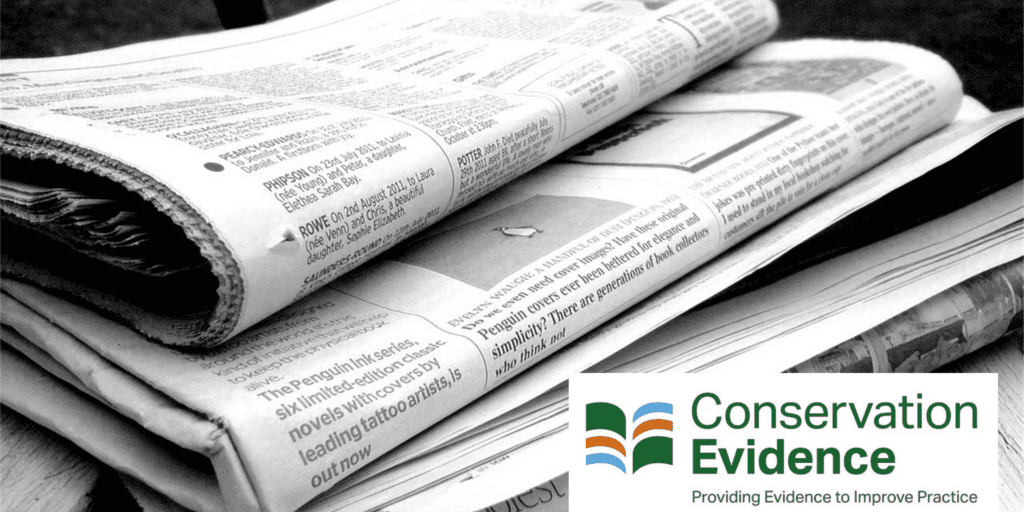Transforming Conservation: A Practical Guide to Evidence and Decision Making
This blog post was written by Bill Sutherland (Miriam Rothschild Professor in Conservation Biology in the Department of Zoology, University of Cambridge and member of BioRISC, the Biosecurity Research Initiative and St Catherine’s College) and Nigel Taylor (Research Associate in the Conservation Science Group, Department of Zoology, University of Cambridge)

In 2002, the low-budget Oakland Athletics baseball team embarked on a 20-game winning streak [1]. In a unit of the Spanish University Hospital Donostia, the risk of death declined by 19% and the length of stay decreased by 29% between 2000 and 2011 [2]. Since the 1970s, the total number of annual fatalities from aircraft flight has tumbled by 5–10 times, despite increases in the number of passengers being carried [3].
One thing underpins all of these significant improvements: evidence-based decision-making.
The Oakland Athletics started to use statistical analyses rather than the opinions of scouts when selecting team members. The Spanish hospital unit became explicitly evidence-based in 2003. Aircraft disasters are followed by thorough review, reflection and, where necessary, changes in practice.
Although there are many excellent examples of evidence-based decision making in conservation, we are still lacking a culture of routine evidence use. For a variety of reasons, evidence is often ignored even when it is available and when making decisions that don’t have a trivial answer. This can lead to inefficient, ineffective and even harmful conservation action. For instance, mangrove planting projects often fail [4], or even destroy valuable habitats like seagrass meadows and mudflats, because they ignore evidence about what conditions are suitable for mangrove tree species and how best to plant them [5].

Examples of evidence-based conservation: (a) An accumulation of evidence – from observations, post-mortem examinations, experiments and interviews – has supported conservation of Gyps vultures on the Indian subcontinent (especially in Nepal) through bans on veterinary use of the drug diclofenac. (b) A culture of evidence use is embedded within the Woodland Trust (a UK charitable organization). The Trust has a dedicated Conservation Evidence and Outcomes team and invest in the systems, processes and training to support this. They regularly synthesize evidence, fund and commission research, and publish evidence-based guidance. Images: Shantanu Kuveskar/Wikimedia Commons & UK Garden Photos/Flickr.
Embedding evidence use into all conservation decision making could help us to achieve so much more with limited conservation resources. For example, a study testing a series of measures to protect birds of prey showed concentrating on effective bird conservation actions could achieve the same outcomes for 22% less investment [6]. Some orangutan conservation actions such as habitat protection and patrolling are 300–400% more cost effective than others like rescue and rehabilitation [7]. In turn, demonstrating that we are using conservation resources efficiently is likely to attract further investment in conservation.
Transforming Conservation is a new book that brings together 76 leading experts in different elements of good decision making in conservation. It guides the reader through the decision-making process, from how to identify stakeholders and frame the problem, to actually making the decision. It discusses how we can embed evidence into policy and practice, but equally how conservation practice can generate new evidence. It also guides the reader through two elements that underpin these processes and thus support effective conservation: (1) collating and assessing evidence and, crucially, (2) creating a culture of evidence use.
The open-access book describes a plethora of accessible tools and techniques to help with evidence-based decision making. These range from the well-established (e.g. experimental design concepts, horizon scanning to identify future challenges and opportunities, methods to collate and review evidence) to the novel and cutting-edge (e.g. ‘dynamic’ meta-analysis, ‘information-source-relevance’ scores to weigh different pieces of evidence, and ‘ziggurat plots’ to display the balance of evidence). The book also outlines principles to encourage evidence use within conservation organizations, such as training and capacity building, and embracing and learning from failure.

Transforming Conservation introduces ‘ziggurat plots’ as a way of visualizing evidence. Each block represents a piece of evidence, with the width reflecting its ‘weight’ (a combination of reliability and relevance; see inset).
Inspired by the benefits of checklists in fields such as medicine and aircraft safety, the book concludes with a set of checklists to help different conservation groups – including funders, practitioners, decision-makers and researchers – embed evidence into their work. Digital versions of these checklists are free to download and modify for individual use from the Open Books website, as is the entire Transforming Conservation book.
When combined with the skills, expertise and passion of the global conservation community, we expect that Transforming Conservation will foster more effective and efficient conservation practice – and ultimately a healthier living world.

Extract from a checklist in Transforming Conservation. There are several checklists throughout the book, designed to support evidence-based conservation.
References
[1] Lewis, M. 2003. Moneyball. The Art of Winning an Unfair Game (New York: W.W. Norton and Company)
[2] Emparanza, J.I., Cabello, J.B. and Burls, A. 2015. Does evidence-based practice improve patient outcomes? Journal of Evaluation in Clinical Practice 21: 1059–65, https://doi.org/10.1111/jep.12460
[3] https://aviation-safety.net/database
[4] https://www.conservationevidence.com/actions/3259
[5] https://www.science.org/content/article/massive-mangrove-restoration-backfires
[6] Santangeli, A. and Sutherland, W.J. 2017. The financial return from measuring impact. Conservation Letters 10: 354–60, https://doi.org/10.1111/conl.12284
[7] Santika, T., Sherman, J., Voigt, M., et al. 2022. Effectiveness of 20 years of conservation investments in protecting orangutans. Current Biology 32: 1754–63, https://doi.org/10.1016/j.cub.2022.02.051




[…] see blog and video by Prof […]